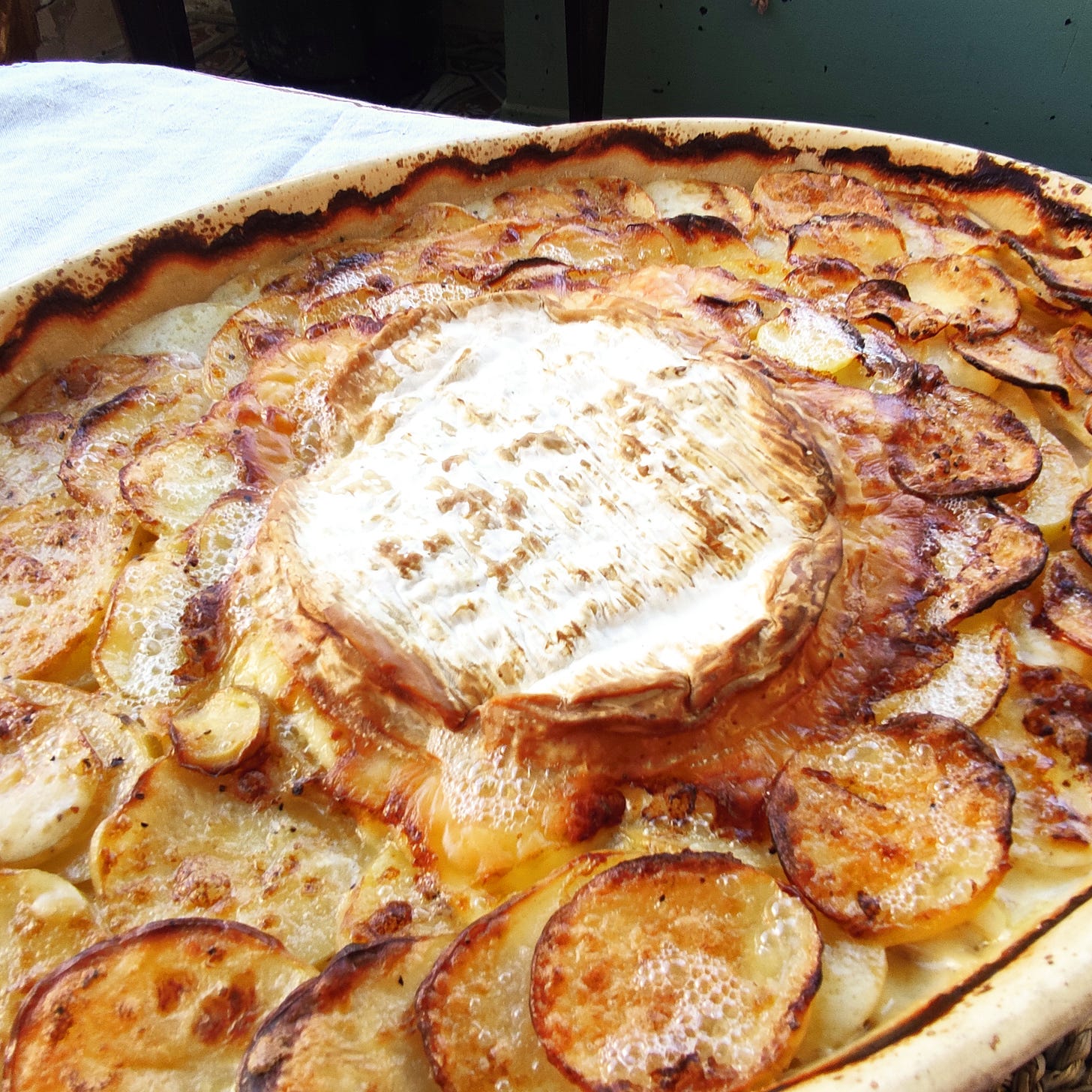Life is beautiful
French women taking up space, laughing, drinking wine and braving the beauty salon. Plus a recipe for a Camembert baked in a dauphinoise, for health.
Every afternoon, even on grey, overcast days, in the small park in front of our house there convenes the best social occasion in town. A group of women, sometimes four or five, sometimes more gather on the benches to chat, pass the time of day, swap stories they may have shared since they were girls. Their ages range from early sixties, to who knows? Some of them have walking frames. There’s often a lady in a wheelchair. Now and again, a husband might join them, or a middle-aged daughter or granddaughter. There are often small, quiet dogs, who snuffle in the flower beds or sit by their owners on the bench. There is usually a lot of laughter, in that afternoon hour. I can hear it as I potter about in the dining room or sit at my desk with the windows open.
There is another group of women, around the same ages, perhaps a little more stylishly dressed, a few more scarves tied just so, more expensive sunglasses, who congregate on the terrace of the bar in the middle of the village on market day. What strikes me about both of these groups is the animated conversation that is the continuation of decades of shared stories, their camaraderie and their confidence. When you read so much about what a killer isolation is, and how prevalent it can be among older people, it is hard to imagine any of these women missing a shift on the bench or on the terrace without the others wondering where they were.
Women here aren’t creeping around the edges of life, they are right in the middle of it.
What strikes me most strongly is that these women are not afraid to take up their space. When I lived in England, I would often read articles written by middle-aged women, or have conversations with women friends who would bemoan that after a certain age, you became invisible. I never really understood this - perhaps I was just racing around, entirely oblivious to the real or perceived slights experienced by my sisters – until I moved here. It’s not that I felt ignored in London, it is just that here, in this busy French village, I feel a lot more paid-attention-to. I go into a shop or other business, and it doesn’t take me minutes to catch anyone’s eye. I can enter a restaurant without subconsciously trying to work out the phrase for, “Do you have a table perhaps not quite so convenient for the loos?” Women here aren’t creeping around the edges of life, they are right in the middle of it.
France is not some kind of feminist utopia, far from it. Women here didn’t even get the vote until 1944, and the gender pay gap between men and women was 16.5 per cent in 2021 (it was 15.4 per cent in the United Kingdom).
But here, in this village, life feels quite matriarchal. There are women who run the local oyster farms, restaurants, the tour boat company and vineyards. We had a friend, a wine writer, who came to stay with us from England. One evening, we took her for dinner to Delicatessen, a local restaurant in the shadow of the church spire. It’s the closest Marseillan gets to a cool, East London vibe, with its tattooed waiters, mismatched tableware and walls full of old school maps, shop dummies and other odd bits of brocanterie. They don’t have anything as pedestrian as a wine list. As you enter, on the left, the walls are lined with shelves filled with bottles of local, organic, biodynamic and otherwise attention-seeking wine, their prices scrawled on the labels in pen. My friend, being a wine person, had quite a detailed conversation with the waitress about what might go with our dinner (charcuterie, confit, steak, it’s that kind of place). Later, as we ate our dinner, drank our wine, the waitress returned to the table to say “The wine maker’s at the bar, if you would like me to introduce you?” (it’s that kind of place). Kate perked up at this point, thinking that meeting a handsome wine maker might just round the evening out nicely. And of course, when the wine maker arrived at the table, she was just as local, dynamic and organic as her excellent wine.
Of course, much is made of French women maintaining their allure, their sparkle, in later life, of being bien dans leur âge whatever age they are. There is a whole industry of slightly fanciful articles and books which claim to share their beauty secrets.
It’s true, French women spend more on beauty products than British, German and Spanish women combined, which will come as no surprise to anyone who has spent more than ten minutes in any half decent French pharmacy. And it is also true that visits to beauticians, with their terrifying magnifying glasses, are part of many French women’s beauty regimes often from quite an early age. (An English friend of mine, who lived in Paris for a few years, was crushed by a visit to such a place where the beautician quizzed her aggressively on how often she exfoliated, but conceded her eye lashes were “Not too bad”. You lose some, you win some.) And you seldom see the vigorously Botox’d, fillered and lifted faces of the kind you see in London and New York, where those smoothed, frozen masks of terror leave you wondering if that person is 35 or 55.
When French women have work done – because they most certainly do, whatever the “French allure” industry might have you believe - it is usually of the very subtle sort where you might wonder if they have just been on holiday, or have perhaps just had an exceptionally refreshing nap. No one cares about a few wrinkles. In fact, they are embraced as evidence of laughter, pleasure, sociability, of a life fully lived.
French novelist Françoise Sagan wrote, “There is a certain age when a woman must be beautiful to be loved, and then there comes a time when she must be loved to be beautiful.” It’s true that the older women I see around me appear happy and confident in their friendships which stretch back decades, in their happy relationships with their often large families, but it’s more than that. It is not simply something that they project out into the world which is then, in later life, is projected back towards them. It is about an ease and a confidence, a delight in the every day and their place in their own village, in their own world. And there is nothing more alluring than that.
Gratin Normand
It was so cold and windy here this week, I pulled out sweaters, scarves and boots. One of the delights of living in this part of France is the almost relentless blue skies, but my English life means I’m heavily invested in knitwear and I miss wearing it a bit. In this cosy frame of mind, I began to think about gratin Normand, a potato gratin baked with a whole Camembert in the middle, the perfect cold weather food. It’ so good and easy to make, too. This weekend, I served it with a winter salad, but it would be a rich accompaniment to any roast, sausages or thickly-sliced ham. Plan a nap for later.
The question I am most often asked about making a potato gratin is what’s the best variety of potatoes to use. You want something that will soak up the crème fraîche and cream but that will continue to hold its shape. I’ve made very good dauphinoises with Amandine, Maris Piper, Desirée, Russets and Yukon Gold potatoes. The other key to success is getting the potato slices thin enough. Some of you living-on-the-edge types might choose to use a mandoline. I am too easily distracted and clumsy for that, plus I am fond of my fingers. I quite enjoy the peace of sitting at the kitchen table slowly and carefully slicing them with a sharp knife. But that’s just me.
If your Camembert is very ripe, it might be a challenge to cut it in half, into two discs. You can make it easier on yourself by putting it in the freezer for 15 minutes before you go at it with a knife. I use a serrated knife, which I think makes it easier too.
Keep reading with a 7-day free trial
Subscribe to Lickedspoon with Debora Robertson to keep reading this post and get 7 days of free access to the full post archives.






